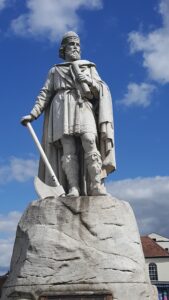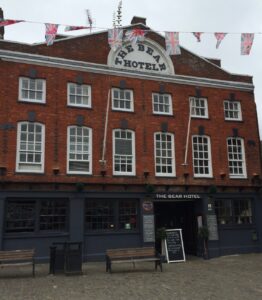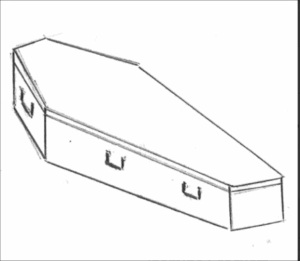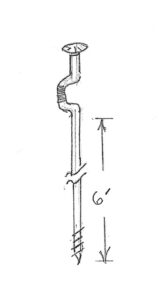If you are a genealogy hobbyist, you have undoubtedly experienced one or more joyful “AHA!” moments of discovery. As my friend and distant cousin Roger Alexander says, “Nobody has more fun than we do!”
AHA! moments strike when you finally locate evidence conclusively proving the identity of an ancestor you have been hunting. That usually happens when you have been doggedly mining whatever records you can find.[1] Then, voilà, your search turns up proof.
I would love to hear your AHA! stories. Please tell me about them with a comment on this blog or, alternatively, via an email. If you don’t have my email address already, I’ll bet you can find it in a New York minute, sleuth that you are.
Here are two of my AHA! moments, one of which concerns an Oakes and the other a Rankin. Also one of Gary’s, which involves a Willis.
Claiborne Parish, Louisiana: the Oakes
My father Jim Rankin grew up in rural north Louisiana in Webster and Bienville Parishes. He was certain that our Rankins were related either by blood or marriage to the Oakes family of Claiborne Parish, but he never figured out the nature of the relationship.
So I was stalking Oakes early on in this hobby, trying to prove that there was an Oakes branch on the Rankin family tree. I worked on the issue for a long time. I had my father’s maternal line back to one set of his great-grandparents, like so:
Jim Rankin, the first genealogist in the family; Emma Leona Broadnax and John Marvin Rankin, Jim’s parents; Susan Demaris Harkins and James Harper Tripp Broadnax, Emma’s parents; and Haney and Isaac Harkins, Susan’s parents.
I dug through available Claiborne Parish records in Houston’s Clayton Library ad nauseam researching those folks. I spread out into their extended families of cousins and in-laws. Clayton has thorough marriage and cemetery records for Claiborne. My Claiborne records expanded exponentially.[2] But I still couldn’t prove a Rankin-Oakes connection.
Gary and I were researching in Salt Lake City sometime in the late 1990s. Back then, the only way one could get county or parish records (other than published abstracts) was at the county courthouse, which was always a good place to meet friendly people. However, it is not a good way to research for two genealogists having virtually no geographic overlap.
Alternatively, one could research in films made by the Church of Latter Day Saints. These filmed records weren’t available online back then.[3] You had to go either to a local Family History Center or the Family History Library in Salt Lake City. The local centers had to order films from SLC, so doing research under those conditions was a slow, painful process. Salt Lake City was far more efficient — and way more fun. We often met relatives or friends there, or made new ones.
So there we were. To review filmed records, one sat in one of what we recall as three long rows of back-to-back microfilm readers at the Family History Library.[4] The microfilm room is dark and the readers are, or were, dusty, huge and archaic. In recompense, the chairs, which swiveled and were on wheels, had comfortable seat and back cushions. But finding and interpreting a specific record in sometimes indecipherable handwriting was always challenging. Sitting in front of a microfilm reader with 40 – 50 other people felt like being in a room full of code breakers in WW II, struggling to decipher enemy messages.
Actually, that’s a pretty good analog all the way around except for the enemy part. Although I occasionally find myself wishing I could exhume a county clerk and shoot him.
On the fateful day in question, the room of microfilm readers was full. You had to arrive when the library opened to get one of the more desirable readers.[5] We were late, so I was 6 or 7 people down one row with an antiquated reader. I was slogging my way through Claiborne Parish records. I found a succession record — called a probate record in most jurisdictions — for one W. L. Oakes in 1892.[6] Bless W. L.’s heart, he died intestate, i.e., he did not have a will. That means all the heirs had to be a party to estate proceedings. There is nothing better for a family history researcher than records of an intestate’s estate.
Better yet for me, as it turned out, W. L. Oakes had no children. Under the Louisiana law of intestate descent and succession, his heirs were his siblings. His widow’s petition for administration of his estate had to name all the heirs and their relationship to W. L. The list of heirs included “Mrs. Haney Harkins, sister of deceased.”
Thus I nailed Haney OAKES Harkins, Jim Rankin’s great-grandmother.[7]
I shoved back from the microfilm reader into the center of the aisle, swiveled my chair in 3 or 4 circles, sticking my arms up and down in the air while making the “V” symbol with both hands. Everyone on the aisle turned and grinned, and everyone knew exactly what had just happened.
Wish Jimmy had been there.
The Elusive, Irascible Samuel Rankin
The very first genealogical research I did was on the Rankin family. Of course. I am one. My father took our line back to a Samuel Rankin of Jefferson County, Arkansas, but could go no further.
In an effort to assemble hard facts, I quickly learned that Samuel’s age was impossible to pin down. In 1850, the census said he was 62. In 1860, he was 60, pulling off the fabulous feat of getting younger over the course of a decade. Inconsistencies multiplied as I found him in earlier records. I called him “Young Sam.”
I also learned he may have been a character. He had sons named Napoleon Bonaparte Rankin (“Pole” was his nickname) and Washington Marion Rankin ( or Marion Washington, “Wash”). What kind of person sticks a kid with those monikers? All told, Young Sam had 10 children, including eight sons. His eldest was named Richard Rankin. If that family employed the Anglo naming system for at least the first few sons, that was a clue that Young Sam’s father might have been named Richard.
The 1850 and 1860 censuses also indicated that Young Sam was born in North Carolina. Arkansas deed records revealed that his wife was Mary Frances Estes, daughter of Lyddal Bacon Estes and “Nancy” Ann Allen Winn Estes of Tishomingo County, Mississippi. Sam and Mary’s first six children were born there.
The Tishomingo records also established that Young Sam almost certainly had a brother William. The Mississippi state censuses added further confusing evidence about his age. I sort of, uh, averaged all the records and guessed he was born about 1800.
So. Here’s what I had to go on. Samuel Rankin, born about 1800 in North Carolina. Likely brother William. Possible father Richard. Whoop-dee-doo.
Armed with that miniscule information, I hauled my rookie researcher self off to North Carolina abstracts and started mucking about in Rankins. This is how I eventually became an expert in North Carolina Rankins. Do you have any idea how many of them there were around 1800? In how many counties? I will leave that for you to suss out. The point is that it was immediately obvious I was in for a long slog. Discouraged, I went back to Arkansas looking for anything.
In the Arkansas section of Clayton Library books, I found one with biographical information on prominent Arkansans. Lo and behold, one of them was Sam’s grandson, Claude Rankin. Claude said that Sam “reached adulthood in Lincoln County, North Carolina.” He then went, said Claude, to Rutherford County, Tennessee.
Off to Lincoln County records I went, armed with additional facts and renewed determination. The prominent Rankin family in Lincoln jumped out of the records in about three seconds: a Samuel Rankin whose wife was Eleanor (“Ellen”) Alexander. Turns out his nickname was “Old One-Eyed Sam.” They had ten children.
Lo and behold, Old One-Eyed Sam had a son who predeceased him named Richard. One problem: Richard lived in Mecklenburg County, adjacent Lincoln on the east side of the Catawba River. Claude expressly said that Young Sam “reached adulthood” in Lincoln County.
Following Claude’s lead, I did more research into the Lincoln County section at Clayton. Fortunately, Clayton has abstracts of Lincoln court records. I was poring through them when I found an indenture dated October 1812 that read as follows:
Ordered that “Samuel Rankin, about 13 years old, an orphan son of Richard Rankin, dec’d, be bound to John Rhine until he arrive to the age of 21 years to learn the art and mistery [sic] of a tanner.[8]
The Clayton chairs aren’t on wheels and they don’t revolve. They are made out of solid wood and weigh a zillion pounds or so. I shoved mine back and stood up, tipping the chair over, and just thrust both hands in the air flashing the “victory” sign. There were a couple of blue-haired D.A.R. types at the next table who looked at me with patent disapproval. The hell with ’em if they can’t take a joke.
Finally, four of Old One-Eyed Sam’s and Eleanor’s children went from Lincoln County to Rutherford County, Tennessee — Claude’s second hint. One of them was Samuel Rankin Jr., who had been appointed guardian of Young Sam when his father Richard died.
Jim Rankin would have patted me on the back and said, “good job, sweetie.” I would have had to admit to him that a review of Mecklenburg court records would have turned up the fact that Samuel Jr., a son of Old One-Eyed Sam, was appointed the guardian of Richard Rankin’s four orphans, including sons named Samuel and William.
Fortunately, the elation of the AHA! moment isn’t dimmed by the fact that one fails to take the easiest route to the destination.
I could also use this story as an illustration of how circumstantial evidence can add up to a rock-solid conclusion. Claude’s two hints, plus an estimate of Young Sam’s birth year and identification of Richard and William as possible names for his father and a brother, add up to a “gotcha!” when you add the Mecklenburg guardian record and the Lincoln indenture. Happily, the fact that Young Sam was from the line of Old One-Eyed Sam and Eleanor Alexander Rankin is confirmed by both autosomal and Y-DNA evidence.
John Willis: the Wantage connection
I am stealing one of Gary’s AHA! moments here. I don’t really know what he went through, research-wise, but I do know about him accidentally tripping over a clue bigger than Dallas.
He traces his Willis line back to a John Willis of Dorchester County, Maryland. John was born about 1680 and was the original immigrant in Gary’s Willis line.
John acquired some Dorchester County land in 1708. Like all of the Maryland landowners of that time, he named his tract. Some were humorous: “Sloane’s Folly.” Others were optimistic: “Smith’s Hope.” John named his tract “Wantage.” That rather peculiar name didn’t ring any bells with either of us. We focused on “Want,” as in I want some good luck.
We should have gone to Maps to see what the name would turn up. What we actually did involves far more Wantage luck.
We are both avid readers. At the time, we were wading through the entire oeuvre of Dick Francis, a former British steeplechase jockey and writer of mysteries involving horse racing.
Gary read one that had an owner trailering his horse through the English village of Wantage. “Robin!!!!,” he said. “Guess what?”
Moral: you can never tell where an AHA! moment might knock you down. Even murder mysteries qualify. Where else, I ask you, can John Willis have come from?
Wantage is a charming village in what is now Oxfordshire County, England (formerly Berkshire), west-southwest of London. We had to go there, of course. We stayed at the hotel in the public square called The Bear. It has (or had) a great pub and a nice breakfast-lunch room lit by skylights. I would describe the bedrooms as “adequate,” but for the fact that a friend of ours — whose taste in hotels and restaurants runs to ostentatious decor and astronomical prices — called our favorite hotel in Paris “adequate” after he stayed there. We love the Mayfair, and would never demean it in that fashion.[9] Using our friend’s rating scale, though, one would probably be forced to call The Bear’s accommodations “primitive” rather than “adequate.” I would nevertheless recommend The Bear to anyone except our friend.
Yes, Wantage has and had its share of men named Willis, a fairly common name in the region. One of Gary’s distant Willis cousins obtained a Y-DNA sample from one of them. Alas, that man is not related to Gary’s ancestor John Willis of Dorchester. In fact, he wasn’t a Y-DNA match to any Willis: he is apparently an NPE. Gary is still looking for Y-DNA proof, but is 99% certain his ancestor’s home was Wantage.
The square in front of the Bear has a wonderful statue of King Alfred, a many-greats grandfather of King Charles. Below are pictures of King Alfred and the Bear. It was obviously a glorious day in merrie olde England. Or perhaps it was merely adequate. <grin>
And that’s all the news that’s fit to print. See you on down the road.
Robin


[1] Evidence includes deed, probate, and tax records, court, military, and Bible records, census data, and/or whatever other county, state, or federal documents you can find. See the article at https://wp.me/p7CQxS-il , which includes a link to an article on the same topic by my cousin Roberta Estes from her “DNA Explained” blog. Relationships in online trees do not, repeat NOT, constitute evidence. They are only clues about family relationships.
[2] Based on advice from a professional genealogist, I organize my research results by county or parish in an idiosyncratic format I refer to as a “data table.” It has worked well for me for at least three decades now.
[3] You can now view images of original county and parish microfilms at the FHL website. It is free and is a goldmine of actual evidence. You can search the FHL catalog by location. Be aware, however, that the FHL website also has family trees having about the same credibility as trees on Ancestry. https://www.familysearch.org/en/search/catalog
[4] Because many of the FHL films of original county records are now available online, newer family history researchers may not have had the Salt Lake City microfilm experience. It was a trip!
[5] The last time we were there, the microfilm readers were mostly unused. Microfilm images can be had on a computer, unless one is researching among “locked” records unavailable unless you are at a Family History Center or the SLC Library.
[6] Claiborne Parish, LA Probate Record E: 799, FHL Film # 265,999.
[7] As it turned out, the Oakes, Harkins, and Broadnax came to Claiborne Parish from Perry Co., AL. Perry records include an 1846 marriage for Haney Oakes and Isaac Harkins. The Oakes issue should therefore have been a piece of cake for me, but for the fact that the Perry County marriage abstract at Clayton showed the bride’s given name as Nancy. Moral: always check the original record. There were several other records in Louisiana and Alabama that could have proved Haney’s maiden name for me. I was a rookie at the time, however, and made every mistake in the book, evidently as a matter of principle.
[8] North Carolina State Library and Archives file, C.R.060.301.4, “Lincoln County, County Court Minutes Jan 1806 – Jan 1813,” p. 589.
[9] The Mayfair Hotel is about a block off the Place Vendôme, where both Coco Chanel and Chopin once resided. The Ritz Hotel is on that square. Jardins des Tuileries are less than a block south of the Mayfair. The Place de la Concorde, where Marie Antoinette and her unfortunate husband met the guillotine, is within a few blocks, at the west end of the Tuileries. It is a short walk to the Louvre (at the east end of the Tuileries) and the d’Orsay (just across the Seine to the south).


 Her idea was to “drill down into some of the coffins to extract DNA.” Thus her nickname. She died not long thereafter, apparently not having succeeded with her DNA recovery project. If she had, any human DNA would undoubtedly have been mixed with pine tree DNA. Not sure if FTDNA could handle that.
Her idea was to “drill down into some of the coffins to extract DNA.” Thus her nickname. She died not long thereafter, apparently not having succeeded with her DNA recovery project. If she had, any human DNA would undoubtedly have been mixed with pine tree DNA. Not sure if FTDNA could handle that.